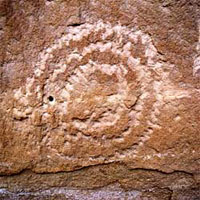TOOLS THROUGH TIME
Universal Tools
The celestial bodies have an endless power to captivate us. We have always watched them, speculated about them, and studied them for patterns. Ultimately, we look to the sky not just to understand the universe, but to seek our place in it.
The tools of skywatching have changed over time. A stick poked into the ground to track the sun's shifting shadows, a rock placed to mark a point in the sky-these have given way to radio telescope arrays and satellites. But look closely at these images, and you'll see that the old saying is true: The more things change, the more they remain the same.
 This close-up image of the sun shows a loop prominence system, high arches of gas associated with solar flares. The image was taken by NASA's Transition Region and Coronal Explorer (TRACE) spacecraft.
This close-up image of the sun shows a loop prominence system, high arches of gas associated with solar flares. The image was taken by NASA's Transition Region and Coronal Explorer (TRACE) spacecraft.
The similarity between these two images is, while striking, accidental. Loop prominences are not visible to the unaided eye.
|
|
|
 This
petroglyph
symbol can be found at various sites around Chaco Canyon-its three concentric circles are understood to represent the sun. Often, these petroglyphs mark sun-watching stations, such as that at Piedra del Sol.
This
petroglyph
symbol can be found at various sites around Chaco Canyon-its three concentric circles are understood to represent the sun. Often, these petroglyphs mark sun-watching stations, such as that at Piedra del Sol.
|
|
|
|

